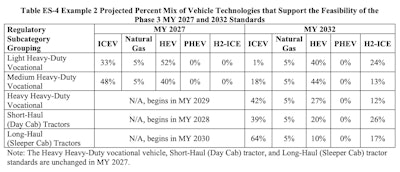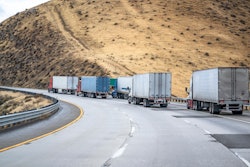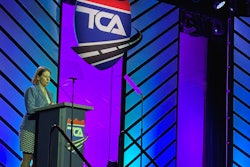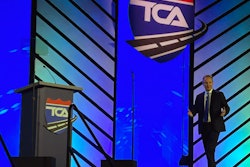The Environmental Protection Agency on Friday set strict emissions standards for heavy-duty trucks covering model years 2027 through 2032.
The new rules are somewhat more strict than those proposed last year. For example, motor carriers will have more time (2027-2030) to build out a zero-emissions infrastructure, but the flip-side is stronger emissions limits in 2031 and 2032. The proposed rule, by 2032, sought to get 50% of vocational vehicles like buses and waste haulers to zero emissions; 35% of new short-haul regional tractors; and 25% of new long-haul trucks – figures that called for more than 40% of all heavy-duty trucks to be zero emissions for trucks in the six model years. Under the 1,155 page final rule, roughly 30% of heavy-heavy-duty vocational trucks would need to be zero-emission by 2032 and 40% of regional day cabs.
[Related: Consumer protections included in Phase 3 EPA rule]
The EPA Phase 3 rule does not specify any particular emissions solution in its rules, maintaining its promise of a "technology-neutral" approach. However, it will be difficult to hit emissions benchmarks without some integration of either hybrid, battery-electric, or hydrogen-electric trucks.
"Given the wide range of operations required of our industry to keep the economy running, a successful emission regulation must be technology neutral and cannot be one-size-fits-all," said American Trucking Associations (ATA) President and CEO Chris Spear, adding ATA opposes the rule in its current form because the post-2030 targets remain "entirely unachievable given the current state of zero-emission technology, the lack of charging infrastructure and restrictions on the power grid. Any regulation that fails to account for the operational realities of trucking will set the industry and America’s supply chain up for failure.”
Truckload Carriers Association President Jim Ward noted that the industry has effectively reduced NOx and Particulate Matters through the evolution and implementation of new technologies and remains committed to being a good steward of the environment, but "the journey ahead provides for many alternatives to be considered to lower carbon such as blended biodiesel, renewable natural gas, diesel-electric, just to name a few to help us bridge the gap to the future. We cannot just sit idly by and watch the implementation of a policy that will have a significant impact on our members business.”

Compared to Phase 2, the Phase 3 standards begin in model year 2027 with a 13% increase in the stringency of the medium heavy-duty vocational vehicle standards and a 17% increase in the light heavy-duty vocational vehicle standards. The Phase 3 day cab tractor standards begin in model year 2028 with an 8% increase in stringency over the Phase 2 standards. The heavy heavy-duty vocational standards begin in model year 2029 with a 13% increase over Phase 2, and the sleeper cab tractor standards begin in model year 2030 with a 6% increase over Phase 2. Each vehicle category then increases in stringency each year, through MY 2032, at which time compared to the Phase 2 program the light heavy-duty vocational standards are a 60% increase in stringency of the CO2 standard, the medium heavy-duty vocational vehicle standards are a 40% increase, the day cab standards are a 40% increase, the heavy heavy-duty vocational standards are a 30% increase, and the sleeper cab standards are a 25% increase in the stringency of the standards.
A report released earlier this month by the Clean Freight Coalition (CFC), an alliance of truck transportation stakeholders whose founding members include the ATA and TCA, among others, found that the full electrification of the U.S. medium- and heavy-duty commercial truck fleet is a nearly $1 trillion enterprise in infrastructure investment alone: upwards of $620 billion from the trucking industry in chargers, site infrastructure and electric service upgrades. The trillion dollar total doesn't include the cost of the trucks themselves, many of which are two and three times more expensive than their diesel counterparts.
CFC Executive Director Jim Mullen said Friday's final rule sets the cadence for the production and adoption of zero-emissions trucks "at a pace that isn’t possible due to the limits of today’s technology. The GHG Phase 3 rule will have detrimental ramifications to the commercial vehicle industry, many small and large businesses, commercial vehicle dealers and their customers."

EPA Administrator Michael Regan called the new rule "the strongest national greenhouse gas standard for heavy-duty vehicles in history" and claimed, in the long run, it will save fleets costs on fuel and other associated expenses. EPA estimates new trucks could save motor carriers upwards of $3.5 billion over the six-model-year period.
While EPA’s final rule includes lower zero-emission vehicle rates for model years 2027-2029, ATA said forced zero-emission vehicle penetration rates in the later years will drive only battery-electric and hydrogen investment, limiting fleets' choices with early-stage technology that is still unproven.
“The trucking industry is fully committed to the road to zero emissions, but the path to get there must be paved with commonsense,” Spear said. “While we are disappointed with today’s rule, we will continue to work with EPA to address its shortcomings and advance emission-reduction targets and timelines that are both realistic and durable.”
Owner-Operator Independent Drivers Association (OOIDA) President Todd Spencer noted that 96% of all commercial carriers are "small business truckers who happen to care about clean air for themselves and their kids as much as anyone. Yet this administration seems dead set on regulating every local mom and pop business out of existence with its flurry of unworkable environmental mandates," he added. "This administration appears more focused on placating extreme environmental activists who have never been inside a truck than the small business truckers who ensure that Americans have food in their grocery stores and clothes on their backs. If you bought it, a trucker brought it.”












